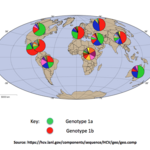Pharmacology

A class of hormonal drugs called aromatase inhibitors substantially reduce the risk of death in postmenopausal women with the most common type of breast cancer, a major study of more than 30,000 women shows.
The research underlines the importance of aromatase inhibitors in the treatment of oestrogen receptor (ER)-positive breast cancer - and shows they reduce risk of death by significantly more than the older hormonal treatment tamoxifen.
The study published in The Lancet is relevant to postmenopausal women with ER-positive breast cancer, which accounts for over 80 per cent of cases which…

“I saw a werewolf with a Chinese menu in his hand,
Walkin' through the streets of Soho in the rain,
He was lookin' for the place called Lee Ho Fooks,
Gonna get a big dish of beef chow mein.”
Aaahoo! …."
Warren Zevon, 1978
" I saw Joe Mercola with the New York Times in his hand,
Looking for some way to explain,
That despite everything he’s said,
There ain't nothin' wrong with As-Par-Tame.
Aaahoo! …."
Josh Bloom, 2015
I've been writing about artificial sweeteners, especially aspartame (NutraSweet) for years. Why?
Well, the same reason that I write anything—to cut through the crap. And…

In the July 24th New York Times, there is a featured article about a new, thorny issue—what to do about the millions of Americans who are infected with the hepatitis C virus (HCV). What makes this particular issue especially tricky is that it involves rationing— about as close to a dirty word in the discussion of modern medicine as you'll ever come across. Rationing of medical care is cruel, inherently wrong, arbitrary, and unacceptable in any fair-minded society. Or is it?
Until 2015, there was exactly one treatment for hepatitis C infection, and it was terrible: Interferon (IFN), an…

In the July 24th New York Times, there is a featured article about a new, thorny issue—what to do about the millions of Americans who are infected with the hepatitis C virus (HCV). This article is a perfect example of the law of unintended consequences. Until recently, there was exactly one treatment for hepatitis C infection, and it was terrible: Interferon (IFN), an immune booster and ribavirin (RBV), a non-specific antiviral which operates by an unknown mechanism. The IFN-RBV therapy is deeply flawed for two main reasons.
First, it is not very effective. The cure rate ranges…

Taking a combination of antidepressants and common painkillers is associated with an increased risk of bleeding soon after starting treatment, finds a study in BMJ.
The researchers say their results may have been affected by other unmeasured or unknown factors and should be interpreted with caution. However, they suggest special attention is needed when patients use both these classes of drugs together.
Depression produces the greatest decrement in health of all common chronic conditions and depression in older people is an important public health problem.
But concern exists that…

New research finds that high vitamin C concentrations in the blood from the intake of fruit and vegetables are associated with a reduced risk of cardiovascular disease and early death.
Fruit and vegetables are healthy, we all know that, and the new paper by scholars from the University of Copenhagen and Herlev and Gentofte Hospital says that the risk of cardiovascular disease and early death falls with a high intake of fruit and vegetables, and that this may be due to vitamin C.
The work is based on the Copenhagen General Population Study, giving the researchers access to data of…

Pain treatment researchers have discovered thousands of new peptide toxins hidden deep within the venom of just one type of Queensland cone snail. The scientists hope the new molecules will be promising leads for new drugs to treat pain and cancer.
Professor Paul Alewood, from UQ’s Institute for Molecular Bioscience, said the team used biochemical and bioinformatics tools to develop a new method to analyze the structure of the venom toxins, allowing them to delve deeper than ever before. “Cone snail venom is known to contain toxins proven to be valuable drug leads,” he said. “This study…

It must be nice to have a job with so much free time on your hands that you can do just about anything, regardless of merit, and not only get away with it, but, rather, be rewarded for it.
Our dear friends, the Environmental Working Group (EWG), perhaps the most scientifically flawed organization out there (and this is no small accomplishment) have decided to take on the (all of a sudden) life and death issue of children drawing with crayons.
Hope you were sitting down when you heard about this.
This non-issue arises from a report, entitled “EWG Tests Find Asbestos in Kids’ crayons, Crime…

A common arthritis drug may also be an effective way to help treat patients with blood cancers—at one thousandth the cost of another drug that works the same way.
Myeloproliferative neoplasms (MPN) cause an overproduction of blood cells resulting in symptoms that include night sweats, itching, and tiredness. MPNs are most often diagnosed in people in their 50s and 60s. Current treatment is limited to aspirin, removal of excess blood, and mild chemotherapy.
Recently, the drug Ruxolitinib has been developed and has been shown to provide relief, but costs more than £40,000 ($62,370) per…

What have I been doing for the last twoweeks, you ask? I’ve been waiting for news on the antibiotic front. The G7 came out with a completely lame statement that has no specific commitments. They suggest they meet together again to share ideas for “best practices.” What we really need is money. But again, no one wants to talk about that.
More recently, Consumer Reports published an article that concentrates on aspects of antibiotic stewardship. While we all agree that physicians and patients should not misuse or abuse this precious resource, Consumer…